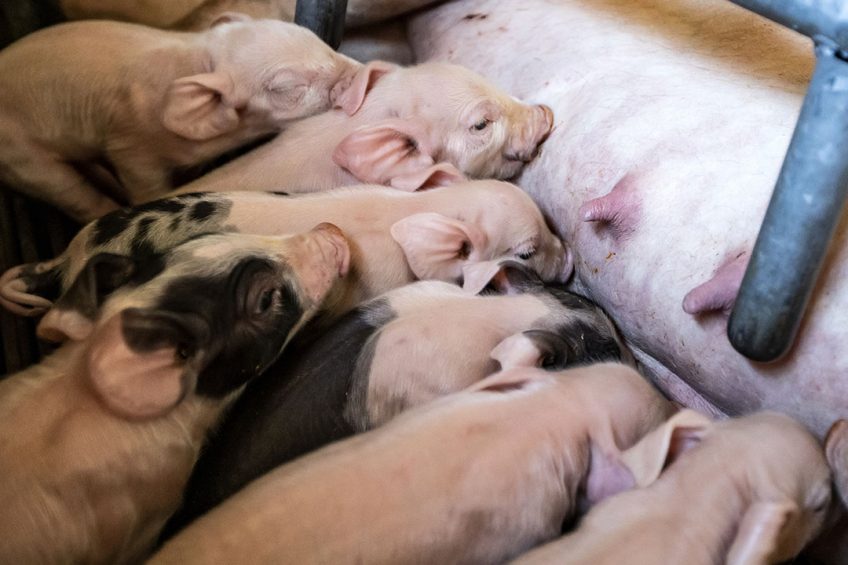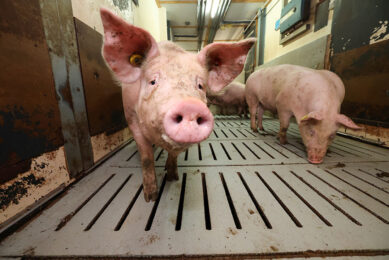Sow feeding levels affect lightweight piglet performance

Low birthweight piglets can perform just a well as their heavier siblings, but taking a closer look at feeding the sow can help give them a better start.
Knowing that weaning weight is a key determinant of lifetime performance, research at the Agri-Food & Biosciences Institute (AFBI) in Northern Ireland, UK, during the past year investigated the growth response of low and average birthweight piglets when reared on sows which were offered different levels of lactation feed intake.
The outcomes were published in 2 publications in the peer-reviewed journals Translational Animal Science and Livestock Science. They aimed to investigate whether any improvements in the weaning weights of low birthweight pigs would be retained during the growing and finishing periods.
Selection for foster farrowing
The study used 32 litters (448 piglets) from the AFBI Hillsborough pig unit from 8 production batches. At each batch, within 24 hours of farrowing, 2 litters of 14 low birthweight pigs (<1kg) and 2 litters of 14 average birthweight pigs (1.25kg-1.75kg) were established on freshly farrowed foster mothers.>
The 2 sows with low birthweight pigs were offered either a high or low, albeit commercially standard, lactation feed allowance. Similarly, the sows with average birthweight piglets were also given either a high or low feed allowance. The ‘low’ feed allowance used in this study was similar to levels fed on pig farms in that sows were fed an average of 6.2kg/day during lactation, with a maximum of 7.5kg/day.
Conversely, sows on a high feed allowance were fed a maximum of 11kg/day and averaged up to 8.6kg/day over the 28 day lactation. The team monitored piglet health throughout lactation and liveweight recorded weekly. Suckling behaviour was also monitored when piglets were 7 and 21 days old.

Read also: The importance of a transition weaning diet
Weaning at 28 days after birth
All piglets were weaned at an average of 28 days after birth. Following weaning, pig liveweight, feed intake and mortality were recorded throughout the growing (4-10 weeks of age) and finishing (12-22 weeks of age) periods until slaughter.
During lactation (28 days), the total intake of sows offered the high feeding rate was 217kg (average of 7.5kg/day), whilst sows offered the low allowance ate 174kg (average of 6.0kg/day), representing a difference of 25%. As expected, the wean weight of low birthweight pigs was lower than that of average birthweight piglets and they also had a higher mortality.
Despite their lower weight, the small piglets had a similar milk intake capacity to that of average weight piglets. Also, as expected, sows who ate the higher feed allowance produced litters with higher weights.
Impact of a high feed allowance
The most interesting results reflect the impact of a high feed allowance for sows rearing litters of low birthweight compared to litters of an average birthweight reared by sows on a low feed allowance.
Birth weight had a major influence on pig performance after weaning, with average birthweight animals weighing heavier than low birthweight pigs throughout production, irrespective of sow feed allowance during lactation. With regard to the impact of sow feed intake, on average, pigs reared by sows with a high feed allowance were heavier at weaning. However, pigs reared on sows offered a low feed allowance showed ‘catch up’ growth during the growing stage (4 to 10 weeks).
This meant there was no difference in weight, feed intake or feed conversion between pigs, regardless of sow feed allowance, from 12 weeks to slaughter and that the weight advantage at weaning was not retained.
 View on demand
View on demand
The research to sow nutrition was also central in this recent webinar held by Pig Progress and Adisseo. It can be viewed on demand.
Catching up with weaning weights
An increase in sow feed intake during lactation will allow low birthweight piglets to achieve weaning weights similar to that of average birthweight pigs reared under current commercial conditions. Pre-weaning mortality of low birthweight pigs can be reduced by almost 50% when reared by a sow who is eating up to an average of 7.5kg/day over the lactation period. Low birthweight pigs which achieved a good weaning weight can match the feed intake and feeding behaviour of heavier pigs in the finishing period.
In general, increased weight in pigs reared by sows offered a high feed allowance was not retained post-weaning. However, it is also noted that the slaughter weight and performance of low birthweight pigs reared on sows with a high feeding allowance was close to that of average birthweight pigs reared on sows with a low feeding allowance.
The study in Translational Animal Science (May 2020) was authored by Samuel J. Hawe, Alan Gordon and Elizabeth Magowan, AFBI, Hillsborough, Northern Ireland, UK; and Nigel Scollan, Queens University, Belfast, Northern Ireland, UK.
The study in Livestock Science (November 2020) was authored by the same scientists and Ramon Muns, also attached to AFBI Hillsborough.











